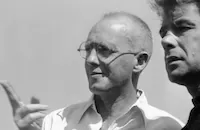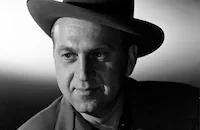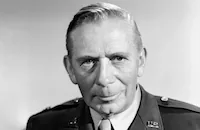Two Years Before the Mast
Brief Synopsis
Cast & Crew
John Farrow
Alan Ladd
Brian Donlevy
William Bendix
Barry Fitzgerald
Howard Da Silva
Film Details
Technical Specs

Synopsis
In 1834, The Pilgrim , a U.S. Merchant Marine ship run by Captain Francis Thompson and owned by Stewart Shipping Company, arrives in Boston from Monterey, California, in record time. Under the orders of Thompson, who brutally abuses his crew, Amazeen, the first mate, who has a blind devotion to his captain, shanghais a crew for the return trip to California. Among those kidnapped are Hayes, a farmer who was not able to notify his wife and children of his departure, and Charles Stewart, the spendthrift son of the company's owner. Stewart quickly learns that the men are fed measly rations while the officers eat fresh chicken, and when he discovers a hungry young stowaway, Sam Hooper, on board, Stewart steals food for the boy and himself, for which the whole crew is punished. Richard Henry Dana, the brother of a sailor who died during the Pilgrim 's last voyage, is onboard to write a book on the atrocities committed under Thompson. When Stewart catches Foster, the second mate, reading Dana's log, they fight, and Stewart is given twenty lashes with a cat-o'-nine-tails for assaulting an officer. In Pernambuco, Brazil, the ship picks up passenger Maria Dominguez and her duenna. As a result of Thompson's refusal to pull into port for fresh provisions, Hayes and another crew member die of scurvy. When Sam becomes sick and crew member Brown discovers that Foster has been hoarding fresh vegetables, Brown kills him. Amazeen, increasingly sympathetic to the crew's intolerable conditions, covers for Brown. When a Mexican island is spotted and Thompson still refuses to stop, Stewart pulls a gun on the him, but is disarmed by Amazeen and locked up to await trial for mutiny, which is punishable by hanging. Maria and Stewart have fallen in love, but she is to be married two weeks after her arrival in San Francisco. When The Pilgrim arrives at the island, Maria appeals to a Mexican officer on Stewart's behalf and accuses Thompson of the willful neglect of his crew. Maria leaves, but Stewart promises to find her. When the captain refuses the crew shore leave, the men free Stewart and abandon ship. When Thompson fires at the boat, Amazeen deflects the bullet, then dives into the water to join the crew and is shot by the captain. After the crew returns to the boat to save their lives, Brown knifes the captain and is himself shot by Thompson. The crew mutinies and flees the Mexican authorities. Some months later, in Boston, the crew is arrested, but Dana's book is published and the crew wins the sympathy of the public. Following a Senate investigation, Congress enacts a law in 1855 protecting the seamen of the Merchant Marine.

Director

John Farrow
Cast

Alan Ladd

Brian Donlevy

William Bendix

Barry Fitzgerald

Howard Da Silva
Esther Fernandez

Albert Dekker
Luis Van Rooten

Darryl Hickman

Roman Bohnen

Ray Collins
Theodore Newton

Tom Powers

James Burke
Frank Faylen
Kathleen Lockhart
Rosa Rey
Pedro De Cordoba
John Roy
George Bruggeman
Clint Dorrington
Carl Voss
John "blackie" Whiteford
Mike Lally
Joe Palma
Dave Kashner
Bink Hedberg
Ethan Laidlaw
Robert Kortman
Rex Lease
Barry Macollum
Edwin Stanley
Crane Whitley
George Carleton
Arthur Loft

Pierre Watkin
Kitty Kelly

James Flavin
Joey Ray
Robert R. Stephenson
David Clyde
Stanley Andrews
Garry Owen
Dorothy Granger
Juan Torena
Ronnie Rondell
Duncan Renaldo

James Millican
Stan Johnson
Byron [s.] Barr

Howard Mitchell
Cyril Ring
George Melford
Alan Bridge
Tom Mcguire
Reginald Simpson
Crew
Franz Bachelin
Jean Bair
George Bruce
Ivyl Burks
Sam Comer
B. G. Desylva
Jan Domela
Hans Dreier
Andy Durkus
Farciot Edouart
Capt. Fred F. Ellis B.m.m. (ret.)
Bertram Granger
Constance Grant
Loyal Griggs
Joy Harrington
Earl Hayman
Charles Huber
Dev Jennings
Gordon Jennings
Clem Jones
M. Kerkess
Roy Krueger
Ernest Laszlo
Paul Lerpae
Sam Levine
Carole Liebold
John Meehan
Seton I. Miller
Seton I. Miller
Charles Morton
Dorothy O'hara
Walter Oberst
Helen Gladys Percey
William Rand
Irmin Roberts
Leonora Sabine
Edward Small
Eda Warren
Wally Westmore
Pat Williams
Philip Wisdom
Charles Woolstenhulme
Victor Young
Joseph C. Youngerman

Film Details
Technical Specs

Quotes
Trivia
Notes
The foreword to the film reads: "Since the first ship sailed under an American flag, the men of the American Merchant Marine have served their nation with silent loyalty. In peace and war they have died maintaining our life lines across the world's oceans. Yet for the first half century America left them unhonored, forgotten...slaves of the ship-masters, wearing their lives out in brutal drudgery. Then a lone man, Richard Dana, rose to champion their cause...so forcefully that his message became an American classic. That message began to take form in 1834, as a tall-masted brig approached Boston Harbor." Richard Henry Dana, Jr.'s novel Two Years Before the Mast was based on notes he took during a two-year voyage from Boston, around Cape Horn to California and back. The voyage began in August 1834 on the brig Pilgrim, and ended September 21, 1836 on the brig Alert. Although Dana switched ships, he was under the command of the same captain throughout his voyage.
In a ship's log, Dana documented the brutality he witnessed, as well as the difficult conditions under which the ships' crews labored. Much of Dana's duties involved the handling of cattle hides on the California coast. Dana reportedly took the trip after a bout with the measles left him with poor eyesight and he was forced to delay his studies at Harvard University. Following the voyage, Dana graduated from Harvard Law School and later became an authority on admiralty law. As in the film, the book contains accounts of unjust floggings by a maniacal captain, crew desertions and incidents of scurvy, but the scurvy did not result in the victims' deaths. Also, the book did not contain a romance between a sailor and a female passenger. Although principal photography was completed in July 1944, the film was not released until November 1946.
As reported in the Variety review, at the time of this film's release, Canadian-born director John Farrow had been only recently discharged from the British and Canadian navies. According to the film's pressbook, it was shot during wartime, completely within the confines of four sound stages at Paramount Studios. The New York Times stated that the decision to make the film on land was the result of difficulties encountered in the production of the 1944 Paramount film Frenchman's Creek. In order to create the effect of unlimited sea and sky space, a cyclorama was set up on the walls of the set and was repainted to represent the skies over Pernambuco, Brazil, Cape Horn and the California coast. Images of vast seascapes and moving cloud backgrounds also were projected against a 36-foot transparency screen. As reported in Cue in July 1946, unused footage of sea and skyscapes that was shot for the the 1937 film Souls at Sea was intercut into this film. Cue also reported that the Boston wharf and two replicas of the 140-foot Pilgrim were built: one floated in a tank that held 640,000 gallons of water with masts cut at the five-story stage ceiling; and the other was built in a rocking barge in an enormous ditch, with fully rigged 90-foot masts that reached into the Hollywood sky. The ship was "rocked" by a series of supporting rockers that were manipulated by motors. As reported in Paramount News, the storm in the film was created with thousands of pounds of ice, which were ground fine to resemble snow and hail; sprinklers, which poured tons of water down on the heads of the actors; and huge fans for wind. The PCA insisted that the flogging in the film be suggested, not shown, and that the action of "Brown" running a sword through "Thompson" be masked from the audience. According to a contemporary source, the cat-o'-nine-tails used were made out of felt rubbed with red lipstick. According to the pressbook, a genuine cat-o'-nine-tails was borrowed from a collector in Nantucket for visual effect. Alan Ladd and Howard Da Silva reprised their roles in a Lux Radio Theatre broadcast on September 22, 1947.












